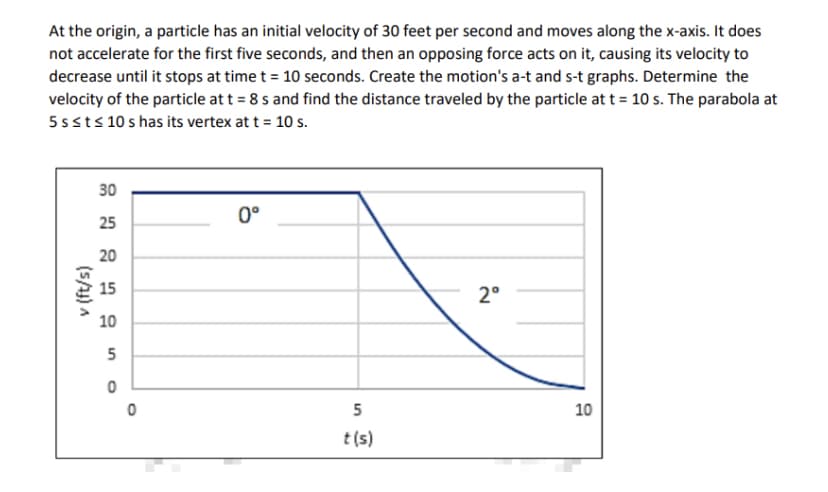At the origin, a particle has an initial velocity of 30 feet per second and moves along the x-axis. It does not accelerate for the first five seconds, and then an opposing force acts on it, causing its velocity to decrease until it stops at time t = 10 seconds. Create the motion's a-t and s-t graphs. Determine the velocity of the particle at t = 8 s and find the distance traveled by the particle at t = 10 s. The parabola at 5 s≤t≤ 10 s has its vertex at t = 10 s. (5/31)^ 30 25 20 15 10 5 0 0 0° 5 t(s) 2° 10
At the origin, a particle has an initial velocity of 30 feet per second and moves along the x-axis. It does not accelerate for the first five seconds, and then an opposing force acts on it, causing its velocity to decrease until it stops at time t = 10 seconds. Create the motion's a-t and s-t graphs. Determine the velocity of the particle at t = 8 s and find the distance traveled by the particle at t = 10 s. The parabola at 5 s≤t≤ 10 s has its vertex at t = 10 s. (5/31)^ 30 25 20 15 10 5 0 0 0° 5 t(s) 2° 10
Classical Dynamics of Particles and Systems
5th Edition
ISBN:9780534408961
Author:Stephen T. Thornton, Jerry B. Marion
Publisher:Stephen T. Thornton, Jerry B. Marion
Chapter2: Newtonian Mechanics-single Particle
Section: Chapter Questions
Problem 2.51P: Let us make the (unrealistic) assumption that a boat of mass m gliding with initial velocity v0 in...
Related questions
Question

Transcribed Image Text:At the origin, a particle has an initial velocity of 30 feet per second and moves along the x-axis. It does
not accelerate for the first five seconds, and then an opposing force acts on it, causing its velocity to
decrease until it stops at time t = 10 seconds. Create the motion's a-t and s-t graphs. Determine the
velocity of the particle at t = 8 s and find the distance traveled by the particle at t = 10 s. The parabola at
5 s≤ t ≤ 10 s has its vertex at t = 10 s.
v (ft/s)
30
25
20
15
10
5
0
0
0°
5
t(s)
2°
10
Expert Solution
This question has been solved!
Explore an expertly crafted, step-by-step solution for a thorough understanding of key concepts.
Step by step
Solved in 5 steps with 2 images

Knowledge Booster
Learn more about
Need a deep-dive on the concept behind this application? Look no further. Learn more about this topic, physics and related others by exploring similar questions and additional content below.Recommended textbooks for you

Classical Dynamics of Particles and Systems
Physics
ISBN:
9780534408961
Author:
Stephen T. Thornton, Jerry B. Marion
Publisher:
Cengage Learning

Principles of Physics: A Calculus-Based Text
Physics
ISBN:
9781133104261
Author:
Raymond A. Serway, John W. Jewett
Publisher:
Cengage Learning

Classical Dynamics of Particles and Systems
Physics
ISBN:
9780534408961
Author:
Stephen T. Thornton, Jerry B. Marion
Publisher:
Cengage Learning

Principles of Physics: A Calculus-Based Text
Physics
ISBN:
9781133104261
Author:
Raymond A. Serway, John W. Jewett
Publisher:
Cengage Learning